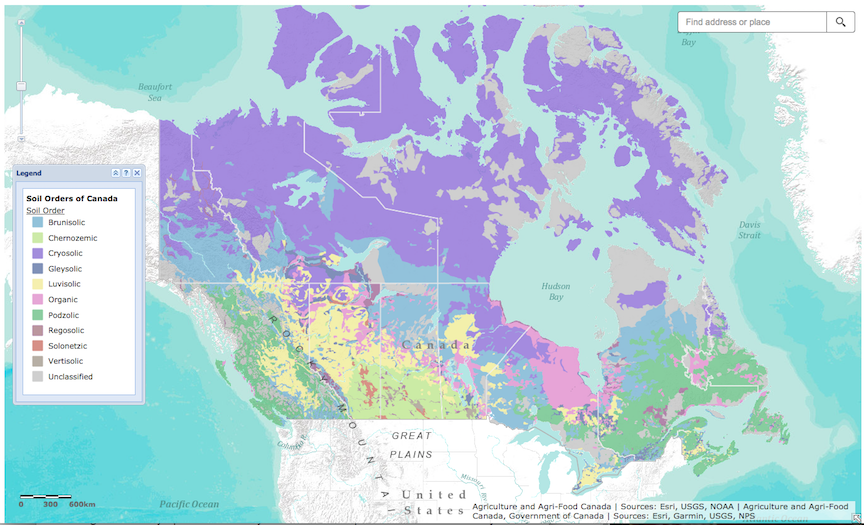8.6 Soils of Canada
Until the 1950s, the classification of soils in Canada was based on the system used in the United States. However, it was long recognized that the U.S system did not apply well to many parts of Canada because of climate and environmental differences. The Canadian System of Soil Classification was first outlined in 1955 and has been refined and modified numerous times since then. There are 10 orders of soil recognized in Canada (Table 8.1), and you can explore the distribution of soils using Agriculture and Agri-Food Canada’s interactive map (Figure 8.26). See the resources section at the bottom of the page for additional sources of information on Canadian soils, including videos.
| Table 8.1 Canadian Soil Classification System |
||
| Order | Brief Description | Environment |
| Forests |
||
| Podzolic | Well-developed A and B horizons | Coniferous forests throughout Canada |
| Luvisolic | Clay-rich B horizon | Northern prairies and central BC, mostly on sedimentary rocks |
| Brunisolic | Poorly developed or immature soil, that does not have the well-defined horizons of podsol or luvisol | Boreal-forest soils in the discontinuous permafrost areas of central and western Canada, and also in southern BC. |
| Grasslands | ||
| Chernozemic | High levels of organic matter and an A horizon at least 10 cm thick | Southern prairies and parts of BC’s southern interior, in areas that experience summer water deficits |
| Solonetzic | A clay-rich B horizon, commonly with a salt-bearing C horizon | Southern prairies, in areas that experience water deficits during the summer |
| Glacial and tundra |
||
| Cryosolic | Poorly developed soil, mostly C horizon | Permafrost areas of northern Canada |
| Vertisolic | Clay-rich soils associated with glacial lake deposits | Southern prairies |
| Other |
||
| Organic | Dominated by organic matter; mineral horizons are typically absent | Wetland areas, especially along the western edge of Hudson Bay, and in the area between the prairies and the boreal forest |
| Regosolic | Does not have a B horizon (i.e., no accumulation of leached minerals) | Unstable sediments including steep slopes prone to landslides, shifting sand dunes, and floodplains where sediments are frequently moved by streams |
| Gleysolic | Colour patterns related to the absence of oxygen | Water-saturated soils |

Processes of soil formation include downward transport of solid and dissolved materials, and the nature of those processes depends in large part on the climate. In Canada’s predominantly cool and humid climate—characteristic of most places other than the far north— podzolization is the norm. This involves downward transportation of hydrogen, iron, and aluminum from the upper part of the soil profile, and accumulation of clay, iron, and aluminum in the B-horizon. Most of the podzols, luvisols, and brunisols of Canada form through various types of podzolization.
In the grasslands of the dry southern parts of the prairie provinces and in some of the drier parts of southern BC, dark brown organic-rich chernozem soils are dominant. In some cases, weak calcification takes place when calcium is leached from the upper layers and accumulates in the B-horizon. Development of caliche layers is rare in Canada.
Organic soils form in areas with poor drainage and a rich supply of organic matter, such as in swamps. These soils have very little mineral matter.
In the permafrost regions of the north, where glacial retreat was most recent, the time available for soil formation has been short and the rate of soil formation slow. The soils are called cryosols (the cryo prefix is used to indicate extreme cold). In permafrost areas, the freeze-thaw process churns the soil, resulting in limited soil horizon development.
Exercise: Soils of Canada
Examine Figure 8.26 showing the distribution of soils in Canada, or use the interactive map by clicking on the figure. For each of the five soils types listed below, briefly describe the distribution. Explain the distribution based on what you know about the conditions under which the soil forms and the variations in climate and vegetation related to it.
| Soil type | Describe the Distribution | Explain the Reason for This Distribution |
| Chernozem | ||
| Luvisol | ||
| Podzol | ||
| Brunisol | ||
| Organic |
Resources
Soils of Canada (University of Saskatchewan)
Soil Classification: Soil Orders of Canada Watch videos about each soil order.

